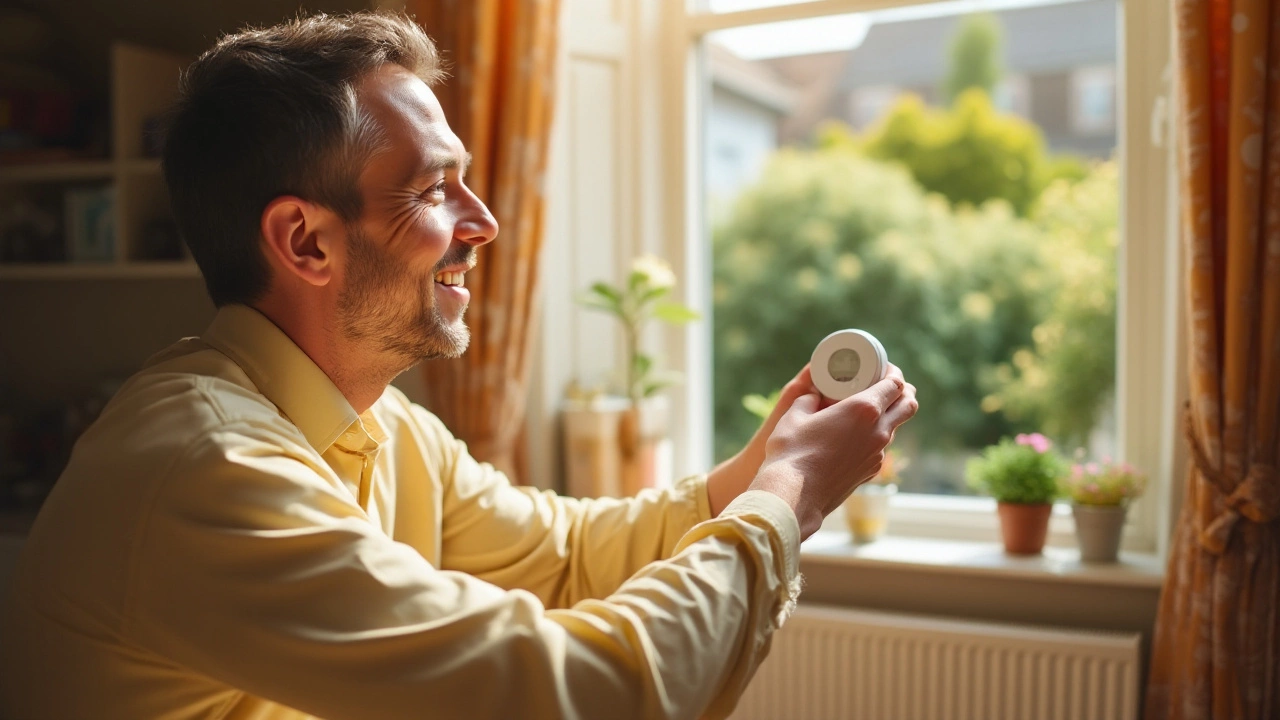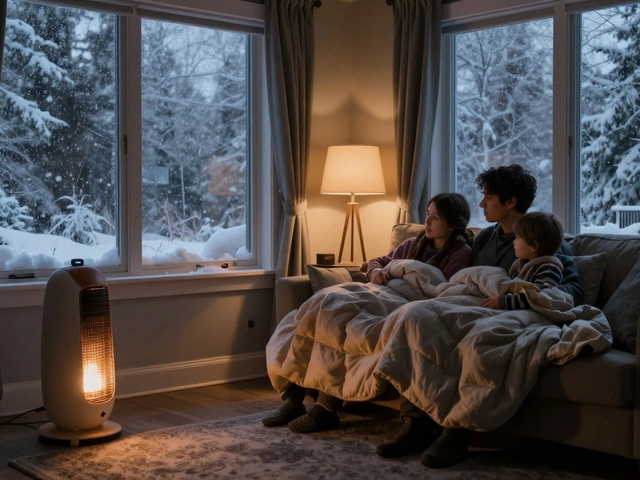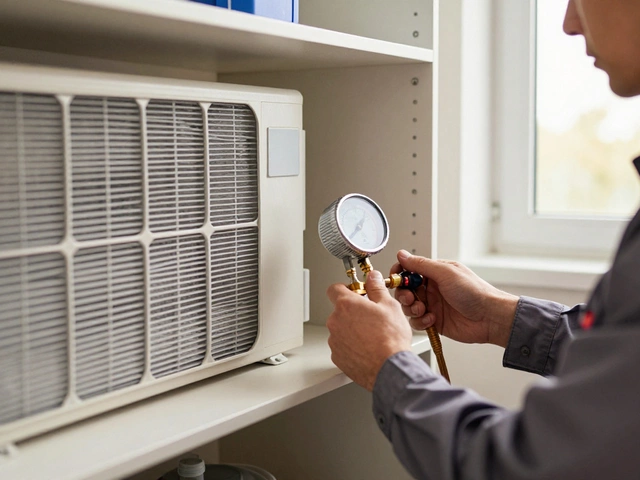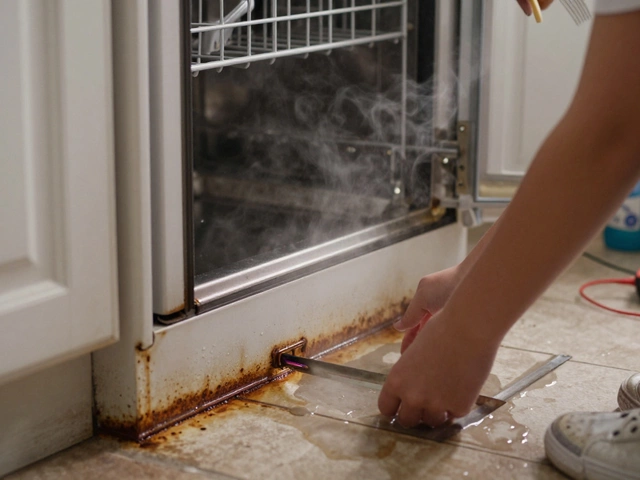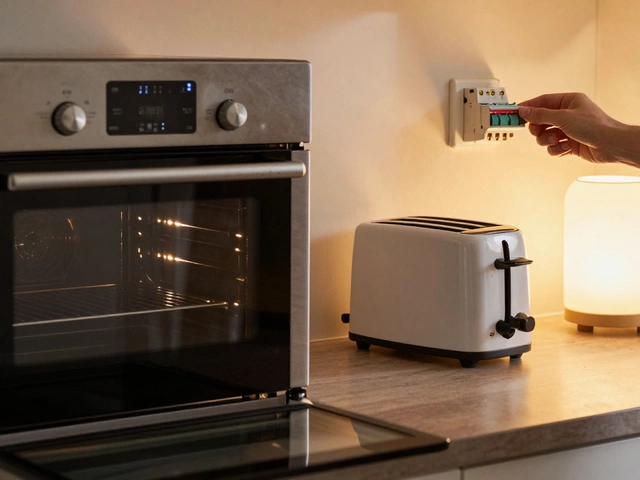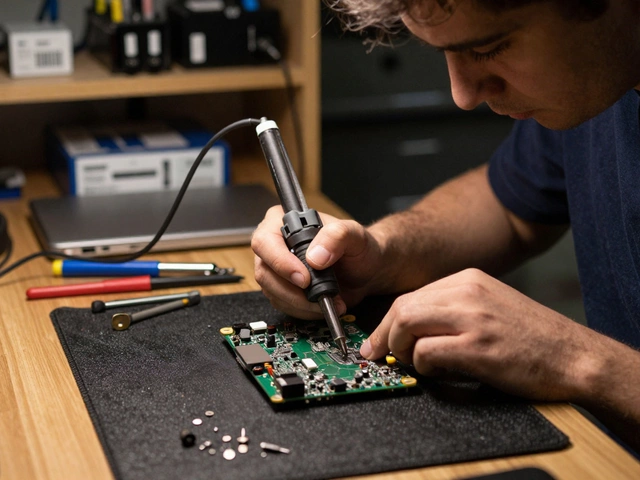Picture this: it's a toasty afternoon, and you're counting on your heat pump to provide a cooldown escape. But alas, the air feels no cooler than it did before turning the system on. Annoying, right?
Before thinking of extravagant repairs, let's delve into a few reasons why your heat pump might be missing that cool factor. From understanding the role of refrigerant to the critical importance of unrestricted airflow, several culprits could be at play. Our journey through diagnosis and remedy aims to shed light on possible issues your heat pump might face. While some fixes can be tackled without backup, others might necessitate expert skills to ensure your comfort and peace of mind. Ready to get things running smoothly again?
- Basic Function of Heat Pumps
- Common Causes of Cooling Failure
- Diagnosing the Problem
- DIY Troubleshooting Tips
- When to Call a Professional
- Preventive Maintenance Tips
Basic Function of Heat Pumps
Heat pumps are the silent crusaders of comfort, seamlessly operating in the background to ensure our living spaces remain at just the right temperature. Unlike traditional furnaces and air conditioners, which generate heat or cold, these ingenious devices transfer thermal energy from one location to another. Imagine it akin to a masterful conductor, orchestrating energy flow to produce either warmth or coolness, depending on your needs. Essentially, they are bidirectional systems capable of reversing their operation, a feature that distinguishes them from single-mode HVAC systems. It means in summer, a heat pump becomes your trusty ally in cooling, while in winter, it sources heat from the frigid outdoors, almost like magic – quite a bit of engineering genius at work!
Here’s an interesting fact: while it might sound odd, heat pumps can pull heat out of cold outdoor air, even when temperatures plummet past freezing. This might raise an eyebrow or two, but it’s true. The process involves refrigerant that cycles through the heat pump’s coils, transitioning between liquid and gas states. During summer, this refrigerant absorbs heat indoors and dissipates it outside, while in winter, the magic reverses. This efficiency isn't lost on experts, either; according to the U.S. Department of Energy, heat pumps provide equivalent space conditioning at as little as one-quarter of the cost of operating conventional heating or cooling appliances.
According to Sarah Smith, a well-known energy efficiency specialist, 'Heat pumps are among the most versatile and efficient systems available today, making them a top choice for those looking to save on energy bills.'This versatility combined with their dual functionality makes them not only a popular but also a smart choice for the environmentally conscious homeowner.
Heat pumps use an intricate system of components to ensure their operation, all working in harmony to provide you with pristine air comfort. The indoor unit, outdoor unit, compressor, condenser, and evaporator coils — each part plays a role in the symphony. As outdoor temperatures change, the unit adapts, supporting a consistent indoor climate. It’s this adaptability that has propelled their popularity, with the International Energy Agency noting a significant rise in their adoption globally. Homeowners have embraced their remarkable cost-efficiency and sustainable attributes. So as we push forward in the quest for greener living solutions, heat pumps emerge as strong contenders at the forefront of the energy game, a feasible alternative that matches our modern-day needs. But how, precisely, do these work each season to handle our heating and cooling? Well, it boils down to some rather neat science and engineering synergy which we'll explore as we dive deeper into potential issues and fixes.
Common Causes of Cooling Failure
Heat pumps, while efficient and versatile, can sometimes hit a bump on the road, leaving you with air that just doesn’t feel quite right. There are several potential reasons your heat pump might be chugging along endlessly but not delivering the refreshingly cool air you crave. Understanding these causes can help avoid downtime and stress. One of the primary suspects in cooling failure is a refrigerant leak. When refrigerant levels dip, the heat pump struggles to absorb and expel heat efficiently, leading to diminished cooling capacity. Without the right amount of refrigerant, your system simply cannot perform its cooling cycle effectively, leaving you sweltering.
Another common culprit is thermostat malfunctions, which can easily throw off your system. Imagine setting your heat pump to 'cool' but unknowingly ending up with lukewarm drafts because the thermostat isn’t calibrated or functioning correctly. This electronic gatekeeper dictates how your system operates, and if it’s off even by a smidge, the whole cycle can be thrown into a whirlwind of inefficiency. Regularly checking and adjusting your thermostat settings can prevent needless hassle.
Experts from Energy Star emphasize, "Regular calibration and maintenance of thermostats can optimize system efficiency by up to 10%."
Then we have the slightly more foreboding issue of airflow blockages. A range of components, like clogged filters or closed vents, can disrupt the flow of air through your system. When air isn't circulating properly, your heat pump struggles to distribute the conditioned air throughout your home, resulting in hot pockets and unsatisfactory cooling performance. Keeping the airflow unobstructed by routinely changing filters and ensuring vents remain open is an easy but often overlooked step in maintaining HVAC efficacy.
Electronics and electrical issues could also be quietly sabotaging your heat pump. Wiring problems or component failures often go unnoticed until the system begins to hiccup in its duties. Faulty connections or worn-out capacitors may silently undercut your system's energy, making it run without achieving the proper cooling. Being proactive with periodic inspections can catch these sneaky issues before they burgeon into significant hassles. HVAC troubleshooting shows that while some problems are apparent, others require an expert's eye, ensuring everything is finely tuned and secure.
Lastly, environmental factors should not be overlooked. Perhaps an unusually hot or humid stretch is stretching your heat pump beyond its limits. This might make it hard for your unit to keep up with demand, especially if it hasn't been sized or installed correctly. Considering these scenarios can sometimes point to why even the most hard-working machines might fall short. As temperatures rise, staying ahead of potential issues with maintenance and proper usage ensures that your heat pump remains an ally in creating the perfect indoor haven.
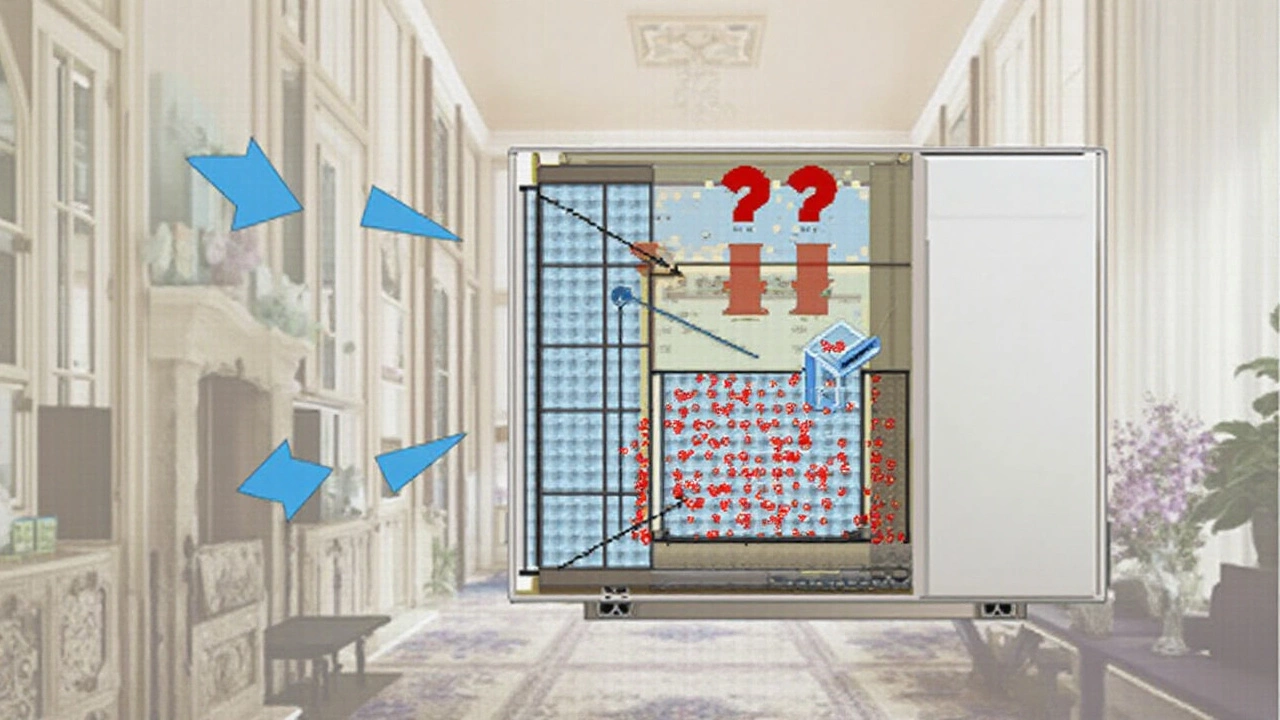
Diagnosing the Problem
When your trusty heat pump is chugging along but the room temperature still feels like a tropical beach, it's time to dive into some detective work. Diagnosing exactly why your heat pump isn't cooling involves a step-by-step approach that starts with the basics and moves to more technical checks. It's not simply guesswork; there's a method to deciphering these mechanical mysteries. Start by ensuring that your thermostat settings are correct. It sounds simple, but a wrongly set thermostat is more common than you'd think. Make sure it is set to 'cool' instead of 'auto' and the temperature is lower than the current room temperature.
Once you've ruled out thermostat issues, it is crucial to eyeball the unit for any visible troubles. Look for obvious problems like ice accumulation or leaks, both of which can be red flags signaling cooling troubles. Speaking of leaks, a refrigerant leak is one notorious reason why the system runs without effectively cooling the air. Modern units are usually sealed tight, so leaks often herald larger issues within the system, potentially involving a technician's expertise. A lack of sufficient refrigerant will not only prevent the heat pump from cooling but might also lead to compressor damage if left unchecked.
If nothing is visually apparent, it's time to listen closely. Unusual noises such as grinding or squealing can indicate mechanical parts that aren't functioning properly—like faulty fans or motors. This is where familiarity with normal operational sounds can come in handy. As you proceed, inspect air filters and vents as blockages here can severely impact the airflow, reducing the system's ability to maintain a comfortable climate at home.
Chris Beasley, an HVAC expert, once remarked, "A well-functioning heat pump is like a symphony; every component must play its part correctly, or the harmony of temperature control is broken."
If you're still encountering issues, the electrical panel could be the culprit. Circuit breakers can sometimes trip, particularly when there is an overload or surge. If the unit is not receiving power, reset any tripped breakers and double-check any loose wiring connections. Electrical components, while challenging to troubleshoot without experience, are a crucial piece of the diagnostic puzzle.
For those who love data, reviewing your electricity bill could offer hidden insights. A spike in energy usage without a corresponding increase in comfort levels might suggest function anomalies in your HVAC system, including the heat pump's inefficiency. This aligns with industry statistics where poorly maintained elements can hike your energy consumption by up to 25%. And for our visually inclined friends, here’s a simple guide:
| Heat Pump Element | Potential Issue |
|---|---|
| Refrigerant Lines | Leaks leading to cooling failures |
| Thermostat | Incorrect settings or malfunctions |
| Filters | Blockage affecting airflow |
After exhausting these self-diagnostics without success, reaching out to a professional will be the next sensible step. With the information you've gathered, a technician can quickly narrow down and address the issue. Staying vigilant with periodic checkups can forestall these headaches in the future, ensuring your heat pump maintains its cool demeanor throughout the summer months.
DIY Troubleshooting Tips
When your heat pump becomes uncooperative, a few preventive yet effective DIY checks might help you out. It’s not always necessary to leap straight into calling for professional services. Many times, a bit of patience and knowledge about your home's trusty climate guardian can save you from headaches and extra expenses. The first port of call is often the thermostat. It might sound cliché, but making sure it's set to the desired mode and temperature could solve your cooling woes. If it runs on batteries, consider replacing them. An improperly set thermostat may not signal the compressor to cool, leaving you with warm gusts instead. Moreover, dust and debris can accumulate over time, impacting this sensitive device's performance, so a quick clean isn't a bad idea.
Another step worth considering is checking the air filter. Filters play a crucial role in maintaining your HVAC system’s efficiency. When clogged, they can obstruct airflow, making your heat pump work doubly hard and still not deliver. Filters should ideally be swapped every one to three months, depending on factors like indoor air quality, pets, and allergy requirements. To ease this process, keep replacement filters at home. Pull out the existing filter and hold it up to light—if light struggles to pass through, it's time for a new one. Speaking of airflow, don’t forget to check the vents around your living space. Ensure they're open and not blocked by furniture or curtains. Restricted airflow can lead to uneven cooling.
Refrigerant levels are another possible hitch in your heat pump’s cooling performance. Low refrigerant could be due to leaks, which diminish the pump’s cooling efficiency drastically. To check for leaks, monitor for hissing sounds or oily patches around the unit. Remember, servicing refrigerant requires special handling, so if you pinpoint an issue, calling a technician is the best way forward. A little-known fact from Energy Star suggests that improperly charged refrigerant can decrease an HVAC system’s efficiency by up to 20%.
According to Bob Vila, "Regularly inspecting and maintaining your heat pump can prevent small issues from becoming costly repairs."
An easy DIY step involves cleaning any debris collected around your outdoor heat pump unit. Trim vegetation and clear leaves periodically. This will prevent system overworks due to blockage in airflow exchange. Ideally, leave around two feet of clearance around the unit for optimum operation. Besides, an annual check on the condensate drain line is beneficial. A clogged line may not seem apparent immediately but could lead to water damage, mold growth, and ineffective cooling. A simple solution to tackle minor clogs is using a wet/dry vacuum to gently clear the drain.
Remember these steps as a recurring maintenance checklist, and your heat pump might just surprise you with its longevity and reliability. Adopting these habits ensures that when summer arrives, you're greeted with the comforting embrace of cool air. Just think of these tasks as showing your home some simple love, which could make all the difference when you least expect it. By doing this, not only are you enhancing the life of your system, but also keeping your utility bills in check. And that, indeed, is a rewarding endgame for any homeowner.

When to Call a Professional
At times, despite our best efforts, a heat pump seems to have a mind of its own, refusing to cooperate. This is when considering professional intervention can become crucial. It's understandable to want to handle things solo, yet there are specific scenarios where calling in the cavalry isn't just wise, but essential. When you suspect a refrigerant leak, this isn't the time for amateur fixes. Only a certified technician possesses the expertise to safely manage refrigerants, ensuring no further harm is done to the environment or your system.
Another tell-tale sign to seek help is if the heat pump frequently switches off or the cycle seems too short. Such behavior commonly results from electrical malfunctions or thermostat glitches that require specialized attention. Apart from risking further damage, these conditions might pose safety hazards if not tended to promptly. We can’t ignore the importance of regular maintenance by professionals as well. Many failures stem from overlooked maintenance which a seasoned expert might catch during a simple routine check.
Complex Mechanical Issues
Imagine hearing strange, unfamiliar noises from your heat pump. It may sound like growling or rattling. These are indicative of potential motor or fan issues. Rather than assuming the worst or ignoring it entirely, a professional can accurately diagnose and repair mechanical complications these noises represent. These issues, if left to fester, could evolve into more costly repairs.
Quoting the Experts
According to Bob Vila, "A skilled HVAC technician can help not only in fixing immediate issues but in also setting your heat pump for a longer, more efficient lifecycle."
This perspective highlights the invaluable role professionals play in extending the lifespan and efficiency of your heating system. Investing in expert help not only resolves present issues but offers long-term savings by maintaining the health of the unit.
The Perks of Professional Insight
Professionals bring more to the table than a simple fix; they offer insights on optimizing your system's performance. They may suggest upgrades or modifications that enhance efficiency, leading to lower operating costs and increased comfort. The diagnostics they use often reveal inefficiencies or impending failures. Thus, by hiring an expert, you’re not just solving the immediate problem but paving the way for a future of uninterrupted comfort.
There are times when you simply have to wave the white flag; it's not surrender but a tactical retreat. Heat pump repair, particularly when it's not cooling, isn't just about fixing the present but ensuring reliability for seasons on end. So, don't hesitate to call in a reliable HVAC expert when necessary—it might just be the smartest move for your home's comfort and efficiency.
Preventive Maintenance Tips
Maintaining your heat pump in tip-top shape is the secret to longevity and reliable performance, especially when the sizzling days demand a cool respite. So, what does preventive maintenance entail? It's straightforward yet critical. A well-tended heat pump runs efficiently, keeping your energy bills in check and your home comfortable. Cleaning and inspection should feature at the top of your to-do list. Ensure the outdoor unit is free from debris. Leaves, dirt, and grass can accumulate around the unit and obstruct airflow, which diminishes efficiency. You might not think twigs and leaves pose a significant threat, but the efficiency of your system largely depends on unobstructed airflow.
Regular filter checks are also essential. Dirty filters can lead to reduced system performance, blocking airflow and forcing your heat pump to work harder than necessary. This overexertion can cause wear and tear over time. Make it a habit to inspect filters monthly and replace them every one to three months or based on the manufacturer's instructions. A clean filter is crucial for maintaining the air quality inside your home and ensuring that your system operates smoothly.
Another critical task in preventive maintenance is scheduling routine professional check-ups. When it gets to more technical aspects like checking refrigerant levels and ensuring that electrical components are in good working order, calling a professional should not be delayed. They have the expertise to identify issues that might slip under the radar. A trusty HVAC professional can help spot potential problems before they evolve into costly repairs.
"Scheduled maintenance can help avoid 95% of all HVAC repairs," according to HVAC consultant James M. Barry.This sentence highlights the importance of trusting experienced hands to care for your system.
Pay close attention to any strange noises or unusual electrical consumption that might indicate underlying issues. Keep a regular eye on the ductwork for any leaks or blockages. Sealing ducts will prevent cool air from escaping and ensure the refrigerated air is distributed uniformly throughout your home. While you're at it, inspect the vents around your home to ensure they aren't blocked by furniture or curtains.
It's worth noting that maintenance isn't just about preserving the operational aspects. It's about enhancing overall energy efficiency which, in turn, translates into financial savings. Investing time into preventive measures can see you reaping the rewards of reduced monthly energy costs. Remember, the idea is to nip any minor issues in the bud before they snowball into something more problematic, demanding costly interventions. Keeping a log of maintenance activities is also a wise move, as it provides a history that you or your technician can reference when evaluating system performance.
